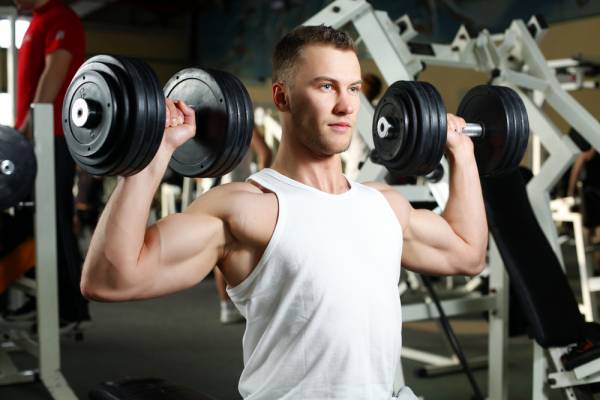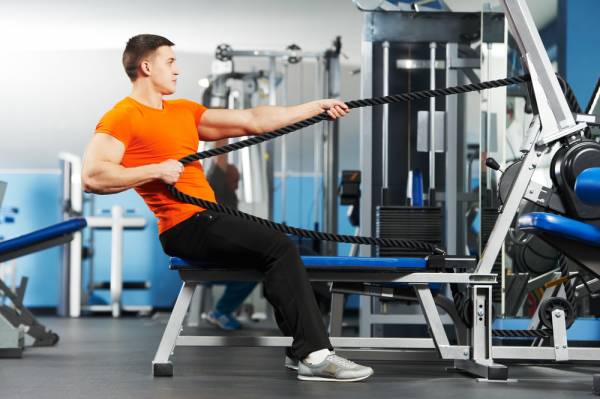Do you sit while you exercise? Maybe you hop on the spin bike, do an exercise circuit on the weight machines, or grab a bench to do your shoulder press or cable rows. If any of these sounds familiar, I’m here to break it to you. Sitting, both throughout the day and during your training is, quite simply, ruining you.
You see, the human body was meant to move. It wasn’t built to sit for extended periods of time. In fact, this sustained posture is actually hugely detrimental to our health and is associated with increased risk of heart disease, certain types of cancer, diabetes, and obesity. Not to mention it does horrible things to our musculoskeletal health, mobility, and posture.
What Happens When We Sit For Extended Periods
The muscles in the front of our hip tighten and can even shorten in length. Not only does this cause dysfunction in the muscles, but it can also lead to or further contribute to a weak core, as these muscles often will take over the work of the abdominals.
Our glute muscles become lengthened and stop working properly. This can lead to our hamstrings being forced to take over during times of hip extension and they can become overworked, translating into greater risk of injury.
The arch in the lower back will either flatten, or even worse, start to round. Alternatively, sometimes people will try to overcompensate for this rounded posture by actually hyper-extending the lumbar spine, essentially jamming their facet joints.
The shoulders hunch forward and upper back rounds. This causes the muscles in the front of the chest to shorten, while the upper back muscles become lengthened and weak. This also leads to the head dropping forward and down, which forces the neck muscles to counteract this movement so you’re not staring down at the ground all day.
Why Are You Choosing to Sit Even More?
Now, if you’re like most people, you have a job that has you sitting for hours at a time, usually in front of a computer or during your daily commute. This means that these changes I just spoke of – these physical and biomechanical changes that lead to pain and injury through altered movement patterns, muscle imbalances, and decreased range of motion – are your reality.
The question then becomes: if this is your reality, why do you want to further contribute to these negative changes and dysfunctional patterns by sitting when you exercise?

You are not doomed if you sit all day. But you better be sure to work hard to counteract those hours you spend at the desk. You need to train properly and strategically. Otherwise, it isn’t a question of if you will face pain and injury, but when.
Now, I will admit that I think the fact that you sit all day is more then enough reason to ditch the seat while you’re exercising. That being said, I also have plenty of other reasons why you should stay away from sitting while you train that might help convince the few out there who still think it’s a good idea.
Goodbye Motor Control
Let’s consider what happens to our muscles when we perform an exercise while sitting. Sure, they become stronger. They get better at shortening and lengthening within the range they are trained (and yes, I said the range they are trained, because most seated exercises often lack end ranges of motion). But what also happens is that we shut off the need for most of our stabilizing muscles to work. This causes our muscles to lack the timing and motor control necessary for functional stability, high performance, and injury resilience.
You see, these stabilizing muscles are absolutely crucial when it comes to our posture, alignment, performance, and prevention of injury. These muscles must be able to anticipate movement and they also have to respond quicker than the rest of our muscles. They are required to hold positions and to control our joint movements as we move and load our bodies.
In other words, these guys are pretty important muscles.
Knowing this, I have to wonder why wouldn’t we train and exercise in a way that utilizes these muscles instead of effectively shutting them off?
Remember, our muscles do not work in isolation. Our stabilizing muscles need to be on and firing before we pick up our groceries, our grandchildren, or a bar loaded with our 1RM. This is exactly why we need to train for how we use and load our bodies in our daily life – and that isn’t sitting down.

Think about it. When do we sit down and push or pull things? Unless you are competing in a strongman competition and pulling some sort of vehicle, it is unlikely you have to do this at anytime in your daily life. When do we lie down on our stomachs and curl our legs back? Sit in a chair and extend our legs? Sit on our butt and press something heavy overhead?
The simple answer – we don’t. In fact, we basically never do these things. So why train as if we do?
Decreased Core and Glute Activity
A recent study published in the Journal of Strength and Conditioning Research examined muscle activity of the core (rectus abdominis, external obliques, and erector spinae) during common resistance exercises in a seated versus standing position. What did they find?
Researchers found that while performing a dumbbell shoulder press neuromuscular activation of these muscles was much lower while sitting than while standing. In fact, the EMG showed that while sitting the activity of rectus abdominis was 81% lower, external obliques 58% lower, and the erector spinae 18% lower. This led the researchers to conclude that in order to enhance neuromuscular activation of these core muscles standing exercises should be used instead of seated.
Let me just repeat that for a minute. While sitting the activity of the rectus abdominis was 81% lower and external obliques 58% lower. People, these are huge numbers.
Sitting down to exercise means our body is no longer activating key muscles. It is no longer working optimally or synergistically as unit. Instead we are creating dysfunctional motor patterns that will lead us right to pain and injury.
In addition to this, when we are in a seated position the chair does all of the work to support the hips and spine – meaning the glute muscles can simply shut off. What ends up happening as you sit more frequently is that the glutes start to activate less and less to the point where your brain actually forgets how to use them, a situation called gluteal amnesia. Ever heard the term “use it or lose it”? Well, that is exactly what happens here.
And do you know what happens when your glutes don’t activate properly? Low back, knee, and hip pain. Decreased stability of your entire core. Poor alignment. Decreased performance. Pain. Injury. In other words – nothing good.

Increased Lumbar Compression
A classic study written by Alf Nachemson in 1981 demonstrated that compared to standing upright, pressure on the lumbar spinal discs increases by 40% while sitting unsupported and by 100% during forward leaning. More recently, Sato et al found that spinal load increased with sitting, and that this further increased with both forward and backward bending.
Now, the reason this happens is well explained by physical therapist Carl DeRosa. He explains that when you stand, the compressive load is distributed with 80% of the load to the bone-disc-bone interface and 15-20% to the facet joints. However, when you sit and you shift your weight forward, almost all of the compressive load (95-100%) goes right to the bone-disc-bone interface.
Though this isn’t a huge deal for a perfectly healthy spine for short periods of time, it can be an issue for those who already have some degree of disc degeneration. And unfortunately, with most people sitting much of the day, many people already suffer from at least a small degree of lumbar disc degeneration. If this is the scenario, sitting can further exacerbate the degeneration and speed up the process leading to further pain, injury and decreased function.
In Conclusion
I will be completely honest with you and tell you that I do not understand how the question of whether you should sit or stand to exercise is still being asked. Articles are coming out left, right, and center about how “sitting is the new smoking,” “sitting is killing you,” and so on and so forth.
We know sitting isn’t good. We know this.
The truth is, sitting is a pathological position and our bodies were meant to move. It’s time to start training them like that.
References:
1. AL Nachemson. “Disc pressure measurements,” Spine, 6 (1981) 93-97.
2. K Sato, K Shinichi, and T Yonezawa. “In Vivo Intradiscal Pressure Measurement in Healthy Individuals and in Patients with Onngoing Back Problems,” Spine, 24 (1999) 2468 -2474.
3. AH Saeterbakken and MS Fimland. “Effects of Body Position and Loading Modality on Muscle Activity and Strength in Shoulder Presses,” Journal of Strength and Conditioning Research, 27 (2012) 1824-1831.
4. Nick Tumminello. “Disc Pressure Measurements – Should it affect exercise selection?” Last modified October 8, 2010.
Photos courtesy ofShutterstock.






